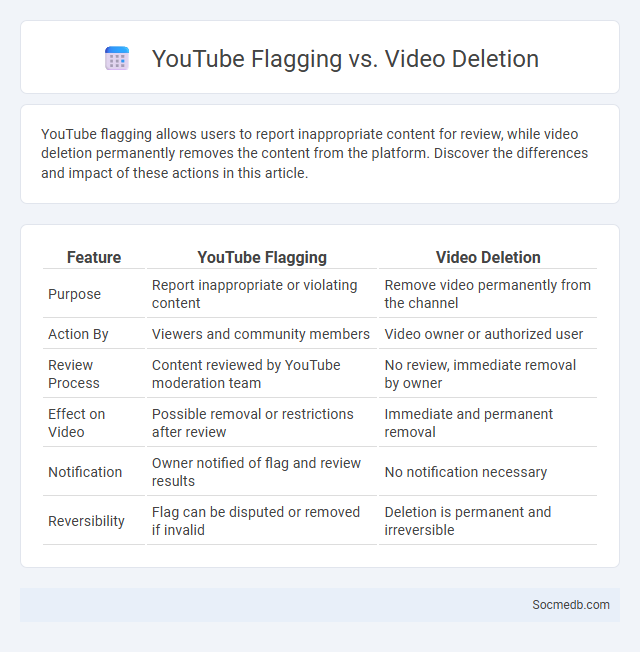
Photo illustration: YouTube Flagging vs Video Deletion
YouTube flagging allows users to report inappropriate content for review, while video deletion permanently removes the content from the platform. Discover the differences and impact of these actions in this article.
Table of Comparison
| Feature | YouTube Flagging | Video Deletion |
|---|---|---|
| Purpose | Report inappropriate or violating content | Remove video permanently from the channel |
| Action By | Viewers and community members | Video owner or authorized user |
| Review Process | Content reviewed by YouTube moderation team | No review, immediate removal by owner |
| Effect on Video | Possible removal or restrictions after review | Immediate and permanent removal |
| Notification | Owner notified of flag and review results | No notification necessary |
| Reversibility | Flag can be disputed or removed if invalid | Deletion is permanent and irreversible |
Introduction to YouTube Content Moderation
YouTube content moderation involves enforcing community guidelines to maintain a safe and respectful platform by filtering harmful or inappropriate videos, comments, and channels. Advanced algorithms combined with human reviewers analyze vast amounts of user-generated content daily, identifying violations such as hate speech, misinformation, and copyright infringement. Effective content moderation ensures compliance with legal regulations while supporting diverse, engaging, and user-friendly social media experiences on YouTube.
What is YouTube Flagging?
YouTube flagging is a system that allows users to report content violating community guidelines, such as spam, hate speech, or inappropriate material. When a video is flagged, it triggers a review by YouTube moderators who assess whether the content should be removed, age-restricted, or demonetized. This process helps maintain platform safety and ensures compliance with YouTube's policies and legal requirements.
Understanding Video Deletion on YouTube
YouTube allows users to delete videos to remove outdated or unwanted content, preserving your channel's relevance and image. Understanding video deletion includes knowing that once removed, videos cannot be recovered and all associated views and comments are lost permanently. Managing your content through deletion helps maintain control over your online presence and complies with YouTube's community guidelines and copyright policies.
Flagging vs. Video Deletion: Key Differences
Flagging on social media allows users to report inappropriate or harmful content, triggering a review process by platform moderators, whereas video deletion involves removing content either by the user or the platform after assessment. Your ability to flag content empowers community-driven moderation but does not guarantee immediate removal, unlike direct video deletion which permanently eliminates the content from public view. Understanding these key differences helps you navigate content control and maintain a safer online environment.
Community Guidelines and Enforcement
Social media platforms implement Community Guidelines to ensure safe and respectful interactions by outlining acceptable behaviors and content standards. Enforcement mechanisms include automated algorithms, user reporting systems, and dedicated moderation teams to identify and remove violations such as hate speech, misinformation, and harassment. Consistent enforcement of these policies is critical to maintaining trust, fostering positive engagement, and protecting vulnerable users across platforms like Facebook, Twitter, and Instagram.
User Experience: Impact of Flagging and Deletion
Flagging and deletion mechanisms significantly improve user experience on social media platforms by reducing exposure to harmful or inappropriate content, thereby fostering safer online communities. These features empower users to report violations swiftly, enhancing content moderation efficiency and platform trustworthiness. Effective flagging and deletion policies also contribute to higher user retention rates by maintaining a respectful and engaging environment.
The Role of Algorithms vs. Human Moderators
Social media platforms rely on complex algorithms to filter and prioritize content, enhancing user engagement by personalizing feeds based on behavior patterns and preferences. Human moderators play a crucial role in handling nuanced cases, enforcing community guidelines, and addressing issues like hate speech, misinformation, and harassment that algorithms may overlook or misinterpret. Balancing algorithmic efficiency with human judgment ensures a safer and more relevant online environment for users.
Appeal Process: Restoring Flagged or Deleted Videos
When your video is flagged or deleted on social media platforms, understanding the appeal process is crucial to restore your content effectively. Each platform typically allows you to submit an appeal, providing evidence or context that your video complies with community guidelines. You must carefully follow the platform's instructions and deadlines to maximize the chances of recovering your video and maintaining your account's standing.
Tips for Avoiding Flagging and Deletion
To avoid flagging and deletion on social media platforms, prioritize creating original content that complies with community guidelines and copyright laws. Use appropriate hashtags and avoid spammy behavior, such as excessive posting or irrelevant tagging, to maintain positive engagement. Regularly review platform updates to align content strategies with evolving policies and reduce the risk of account penalties.
Future Trends in YouTube Content Moderation
Future trends in YouTube content moderation emphasize the integration of advanced AI algorithms and machine learning models to enhance detection accuracy and reduce harmful content proliferation. Increased reliance on real-time automated systems aims to address misinformation, hate speech, and copyright violations while balancing creator freedom and platform compliance. Collaboration with external fact-checkers and community guidelines refinement will play crucial roles in shaping transparent and effective moderation policies.
 socmedb.com
socmedb.com